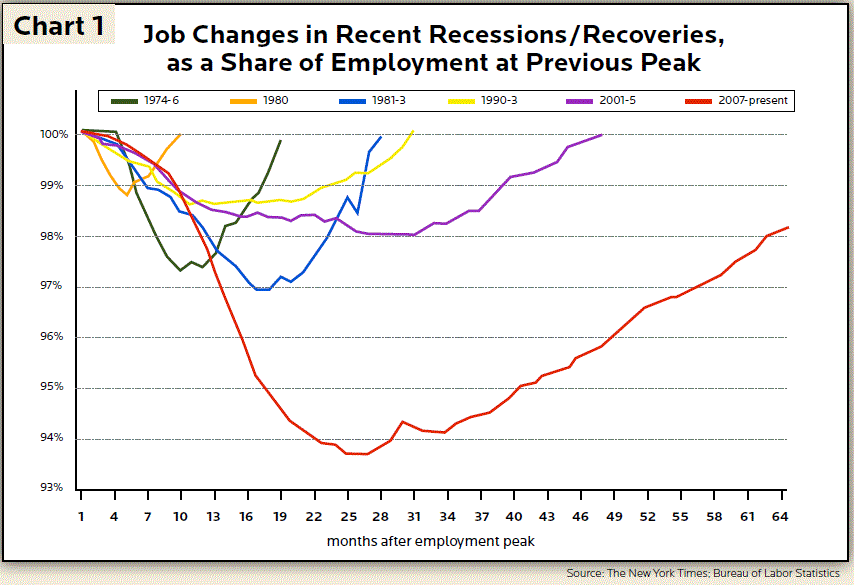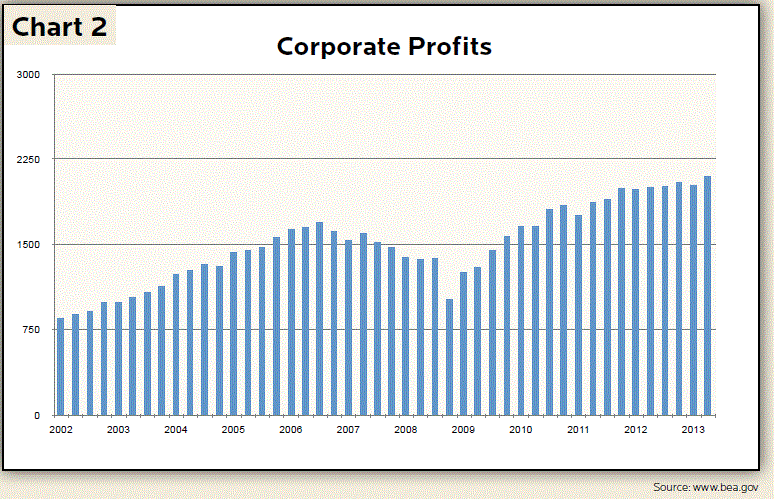,
September 30, 2013

The employment situation in the United States can be confusing. Unemployment remains stubbornly high, and the percentage of the population participating in the labor force fell from 66.4% in 2006 to just 63.2% today. Yet new job creation has averaged 162,000 per month since March of 2010. Are we still in recession or now in recovery? We fell into a very deep economic hole and, after four years of steady climbing, we are only half way out. This can be interpreted in two ways…either we remain very far below our optimal performance or we have many years of growth yet to come. In fact, both perspectives are true.
During the “Great Recession” 8.7 million people lost their jobs. On top of this an additional 5 million young people entered the job market since 2007, thereby digging an unemployment hole approximately 14 million jobs deep. So far, the recovery has partially filled the hole with 6.8 million jobs. We borrowed Chart 1 from the New York Times to illustrate the sheer size of this current economic hole relative to previous recessions.
The steep red line represents the 64 month period following the initial drop in employment levels from approximately February 2008 through May 2013. Layoffs mounted for 25 months, ultimately throwing more than 6% of the labor force out of work. Employers started hiring again in March of 2010, but we have not yet fully recovered all of the lost jobs. As you can see from the red line in Chart 1, our experience during this recession is very different from previous economic downturns.
Now compare the red line which represents the current recession and recovery with the blue line which represents the 1981 – 1983 recession and recovery. Prior to the recent recession, the 1981 to 1983 period was the worst economic downturn since the Great Depression. During the 1981 – 1983 recession interest rates approached 20%, inflation was in double digits and the unemployment rate peaked at 10.8%.
Once the economy bottomed in the early 1980’s, however, the turn-around was rapid. All of the lost jobs were essentially regained in less than 12 months, a very different outcome from the current sluggish recovery. The three recessions in the 1970’s and 1980’s were V shaped, distinguished by sharp job losses and equally sharp recoveries. The situation began to change during the 1990 – 1991 recession. For the first time layoffs and recoveries looked more like a U rather than a V (see the yellow line in Chart 1). In other words, layoffs lasted longer and reemployment also took a longer period of time.
Starting with the 1990 recession the word “layoff” became an anachronism. As the U.S. entered the information age, industrial workers were no longer “laid off” waiting to be recalled by their employers once business picked up. As automation eliminated entire job categories, layoffs turned into permanent firings. Productivity growth accelerated and profit margins improved, but unemployed workers often needed to find new companies or even brand new fields. Sometimes a period of education or training was required to acquire employable skills. All of these activities required much longer periods of time than classic layoffs.
During the 2001 – 2003 and the 2007 – 2009 recessions the trend became much more pronounced. The collapse of the technology bubble produced modest job losses (see the purple line in Chart 1). Nonetheless it took almost 4 years for all of the fired employees to find new work. Even though 6.8 million new jobs have been created since the Great Recession ended, we are still years away from a full employment recovery.
The financial crisis and the bursting housing bubble eliminated an estimated one million construction jobs, most of which will ultimately return as households and financial institutions repair their balance sheets. In most other sectors of the economy, however, job growth will only come from new employment opportunities rather than the restoration of old positions. Technology and intensified global business competition continue to evaporate millions of jobs. The recession merely accelerated this long-term trend. Chart 2 highlights the flip side of this employment pain as American companies achieved record profits and restored competitiveness.
 Future Jobs
Future JobsIn the early 20th century about 40% of the American labor force worked in agriculture, today less than 2% work on the farm. Similarly, manufacturing employment fell by half over the past 40 years to approximately 10% of the U.S. work force today. Despite recent wishful thinking, these jobs are very unlikely to come back. If they do, they will be skilled technical positions rather than assembly line workers. Bemoaning the destructive forces of capitalism is both eternal and futile.
As in the past, permanently lost jobs will be mostly replaced by new occupations. Early 20th century farmers and 1960’s factory workers could not have imagined the plethora of innovative new occupations. Examples abound…artificial knees and hips require more orthopedic surgeons, but also their specialized physician assistants and physical therapists. The convergence of the internet, data storage and powerful computers into “Big Data” is creating entirely new industries to collect, sell and interpret information. Demand for technically proficient database administrators, developers, and analysts will continue to surge. Newer fields such as smartphone apps, genetic testing, 3-D printing, electronic payments, advanced materials, and enhanced oil & gas exploration – just to name a few – could create thousands of new jobs. To handle all of this increased complexity the Bureau of Labor Statistics estimates an additional 1.7 million positions will be needed in business and financial management by 2020.
Organizations continuously automate many routine job tasks, but they will require millions of additional people to manage our more complex and competitive world. For example, file clerks and new account processors are rapidly being eliminated. So are photography processors, machine tool operators, machine setters, meter readers, stock clerks, order fillers, data entry clerks, compilers, model builders and assemblers. In fact, many jobs with the title “clerk”, “processor” or “operator” can be automated, but require higher value-added services from “administrators”, “managers”, “analysts”, “technicians”, “advisors” or any number of specialized assistants.
The technical competency of the American workforce must increase through education and training to match the growing information content and complexity of the work required. Even in better economic environments the skills offered by the workforce lags behind the skills demanded by employers, but the “Great Recession” opened a wide chasm that will only be filled over many years.
The U.S. economy is indeed climbing out of a very deep hole, and should keep climbing. Real innovations and trends are what propel us forward, not just artificial government stimulus. Most of these innovations and trends are obvious to all of us, but it may be difficult to understand how they ultimately replace the jobs just lost. Perhaps our main solace can be found that in every recession new opportunities eventually outnumbered those lost positions. The gap between our economic potential and our current economic performance is quite wide, but closing the gap will drive the expansion of our economy. In other words, economic growth will come from creating new and continued opportunities for employment and investment.
Investment Insight is published as a service to our clients and other interested parties. This material is not intended to be relied upon as a forecast, research, investment, accounting, legal or tax advice, and is not a recommendation, offer or solicitation to buy or sell any securities or to adopt any investment strategy. The views and strategies described may not be suitable for all investors. References to specific securities, asset classes and financial markets are for illustrative purposes only. Past performance is no guarantee of future results.